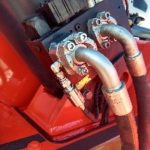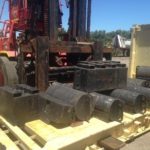WEIGHING EQUIPMENT AND SCALE INSTALLATION
General and Industrial Weighing Scale Installation
In general, most bench top scales and floor platform scales do not require the services of a scale technician to install.
The important things to remember when installing such a scale are:
-
- The scale must be installed on a firm solid base that will always support the weight of the scale and the weight of the heaviest materials that will be placed onto it.
- The scale must always be level and all adjustable leg supports supporting its weight distribution are all supporting the scale in its level position.
- Any cabling must be protected from possible damage.
- All electrical components like power points must be installed according to the Government laws .
- Any remote displays are mounted correctly and where they can be seen by the viewer.
- These types of scales are usually supplied as a calibrated scale from the retailer and NMI Form 6 certification completed if it is a Trade Approved scale.
- If the scale is installed at its location and this location is either 400km North or South of the latitude of where it was initially calibrated by the retailer of the scale, this scale should be calibrated once installed as the calibration will be affected by changes in the earth’s gravitation.
Here are some example scenarios:
-
- if the scale is calibrated originally in Brisbane and installed in any other capital city it would have to be recalibrated.
- if the scale is calibrated originally in Sydney and installed in Perth this would not have to be recalibrated as the latitude North or South of Sydney has not exceeded 400kms.
- if the initial seller/calibrator of the scale is made aware of the location that the scale will be installed at, most digital scales have the ability to be gravity compensated for during the initial calibration process to allow for the change in its latitude location.



Scales requiring civil works such as weighbridges and other large scales
-
- Council approval must be obtained
- All civil works should be completed by compliant civil contractors
- All concrete work should be completed by compliant concrete worker as solid construction and level work to the dimensions is essential.
- All connecting electrical work (such as mains power supply) must be done by authorized electricians as per the laws.
- These types of scales will required onsite calibration after the installation is completed.
Installation of a scale that measures the pressures of the machines hydraulic system that will be installed onto such machines as front end loaders, excavators, telehandlers and reach stackers)
It is essential that the installation of such scales be completed by a scale technician associated with the company that has sold the scale, as the accuracy of the scale can be effected greatly if not installed correctly.
As most of the digital parameters of these scales are code protected so that untrained persons cannot accidently or intentionally access the calibration modes, all calibrations must be conducted by the supplier’s technician.
Also, the laws of Australia Government Body called National Measurement Institute (NMI) allows only licensed scale technician to service, repair or calibrate any Trade Approved scale. Regulation 13 certified standard test masses must be used when calibrating a Trade Approved scale.
NMI also has laws relating to the use of a Control Instrument and the use of Substitute Test Masses, which if used must only be used as per the NMI legislation.
Only licensed scale technician know all the NMI laws pertaining to the calibration of a Trade Approved scale.



New Australian Maritime Safety Authority (AMSA) laws relating to any scale used to determine the VGM weight of an export sea container. Legislation is effective 1st July 2016.
These laws effect any scale (existing or new scale) that will be used to weigh an export sea container to determine the Verified Gross Mass (VGM) of the container (using either weighing method known in the legislation as Method 1 or Method 2). These laws apply should the export sea container as part of its transportation be placed on any vessel that is on water for shipment. The AMSA laws are a mixture of their AMSA laws (meaning that any scale either a Trade Approved scale or a NON Trade Approved scale maybe used) to determine the VGM. But, before such initial use and then periodically thereafter that scale must be tested to the Australian NMI laws regarding the testing of a scale of that type/capacity.
AMSA laws also include that the test masses used must be the NMI Regulation 13 certified standard test masses.
Whether your company uses either a weighbridge, general or industrial platform scales, or scales installed on either, forklifts or reach stackers for AMSA weighing of an export sea container to determine its VGM, consult with Instant Weighing to make sure that your scale is tested correctly and that the written test reports will be acceptable and compliant with the AMSA legislation should your company be audited by a AMSA Inspector.
